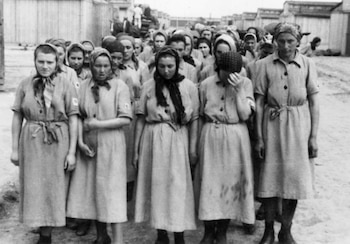INTERNACIONAL
Former Clinton aide Huma Abedin, Alex Soros marry in swank Hamptons wedding packed with Dem heavyweights

NEWYou can now listen to Fox News articles!
Former top Hillary Clinton aide Huma Abedin and Alex Soros, son of billionaire left-wing donor George Soros, married in a lavish wedding in New York on Saturday that reportedly drew attendance from high-profile Democrats stretching from former Vice President Kamala Harris to former Speaker of the House Nancy Pelosi.
The couple married in Water Mill, N.Y., at a Soros family estate on Saturday, according to the New York Times, which reported the swank Hamptons wedding drew private jets, fleets of black SUVs «and Clinton aides galore in a rare concentration of wealth and power.»
Democrat heavyweights including Bill and Hillary Clinton, Senate Minority Leader Chuck Schumer, Harris – as well as her husband Doug Emhoff – and Pelosi attended the wedding, the New York Times reported. Other celebrities and high-profile attendees included Vogue’s Anna Wintour, socialite Nicky Hilton Rothschild, and Albanian Prime Minister Edi Rama, the outlet reported, citing attendees.
«I’m looking forward to being a witness to their marriage; to the celebration that we all are going to be part of; to seeing so many longtime friends gathered in one place to really enjoy being part of Huma and Alex’s start of their married life. And I think we all could use some fun, so I’m looking forward to all of it,» Hillary Clinton told Vogue of the wedding in an article published Saturday.
CONSERVATIVES MOCK DEM RHETORIC ABOUT ‘OLIGARCHY’ AS NYC LIVING ROOM PIC OF ALEX SOROS AND ABEDIN GOES VIRAL
Huma Abedin and Alexander Soros attend The 2024 Met Gala Celebrating «Sleeping Beauties: Reawakening Fashion» at The Metropolitan Museum of Art on May 06, 2024 in New York City. (Photo by Cindy Ord/MG24/Getty Images for The Met Museum/Vogue) (Getty Images)
Soros, 39, is the chairman of the Open Society Foundations, which is a massive $25 billion nonprofit founded by George Soros, 94, and helps bankroll left-wing causes and politicians across the country. Abedin, 48, is the former longtime aide to Hillary Clinton and often called the former secretary of state’s «second daughter.» Abedin was previously married to disgraced former New York Democratic Rep. Anthony Weiner.
ALEX SOROS IN HOT SEAT AFTER LEFT-WING OUTLET EXPOSES WHAT HIS DAD’S NETWORK THINKS OF HIS ONLINE FOOTPRINT

Then-U.S. Secretary of State Hillary Clinton (R) receives a note from her aide Huma Abedin (L) as she testifies about the State Department’s FY2012 budget during a hearing of the State, Foreign Operations and Related Programs Subcommittee of the House Appropriations Committee in the Rayburn House Office Building on March 10, 2011 . (Photo by Jonathan Ernst/Getty Images) (Getty Images)
The wedding included a live performance from Boyz II Men, the vocal harmony group behind hits such as 1991’s «Motownphilly,» according to the Times, as well as toasts from Hillary Clinton, Wintour, and the Albanian prime minister. Abedin wore two custom wedding dresses over the course of the day, Vogue reported.
EX-CLINTON AIDE HUMA ABEDIN ENGAGED TO GEORGE SOROS’ SON

Alex Soros and political staffer Huma Abedin arrives at the Booksellers Room of the White House on the occasion of the State Dinner with the Kenyan president at the White House in Washington, DC, on May 23, 2024. (Photo by SAUL LOEB / AFP) (Photo by SAUL LOEB/AFP via Getty Images) (Getty Images)
The wedding’s menu reportedly included cuts of Wagyu beef, grilled prawns and chilled English pea soup.
Soros popped the question to Abedin in July of last year, sharing the announcement on his Instagram page at the time.
MSNBC CONTRIBUTOR, LONGTIME CLINTON AIDE HUMA ABEDIN DATING GEORGE SOROS’ SON

Anna Wintour, Hillary Clinton, and Huma Abedin pose backstage at the 2018 Glamour Women Of The Year Awards: Women Rise on November 12, 2018 in New York City. (Photo by Cindy Ord/Getty Images for Glamour) (Getty Images)
«This happened…we couldn’t be happier, more grateful, or more in love,» Soros wrote in an Instagram post, accompanied by a photo of him on one knee.
CLICK HERE TO GET THE FOX NEWS APP
Abedin told Vogue of her engagement: «I was shocked, not by the fact that he proposed, but it was the timing that made no sense. It was a very hectic, very chaotic day, and I was leaving for a trip the next day. I went to get my hair colored in the morning [and] I dropped something on my foot, so I was wearing sneakers.»
Fox News Digital reached out to the Open Society Foundations on Sunday morning inquiring if representatives for the couple had any additional comment to include on the wedding, but did not immediately receive a reply.
INTERNACIONAL
Fox News Poll: Support for deportation depends on who is being targeted

NEWYou can now listen to Fox News articles!
As the U.S. Immigration and Customs Enforcement Agency, or ICE, continues to crackdown on illegal immigration, about half of voters say the department is too aggressive in its deportation efforts. Furthermore, while support for deportation is high, it depends on who is being targeted.
The latest Fox News survey, released Monday, finds 3 in 10 back deporting all illegal immigrants, while 6 in 10 supports only deporting those charged with crimes but would allow others to stay and apply for citizenship. One in 10 favors letting all illegal immigrants remain in the U.S.
Since 2015, a majority has generally favored the deportation of illegal immigrants.
FOX NEWS POLL: THE GOP IS SEEN AS MORE LIKELY TO HAVE A CLEAR PLAN FOR THE COUNTRY
Republicans (54%) are about eight times more likely than Democrats (7%) to say all illegal immigrants should be deported, and one-quarter of independents agree (25%).
Roughly 8 in 10 Democrats, 6 in 10 independents, and 4 in 10 Republicans agree that at least illegal immigrants charged with crimes should be deported, while others should be offered a path to stay.
On the current approach to deportation, however, views are divided. Half, 49%, feel ICE has been too aggressive in its efforts to deport illegal immigrants while a quarter (24%) say it has not been aggressive enough. Nearly 3 in 10 say deportation efforts are about right (27%).
Most Democrats think ICE is too aggressive (81%), while Republicans are split between saying its actions are about right (43%) or not aggressive enough (40%). Some 17% of Republicans think ICE has been too aggressive.
Independents are more likely to say the agency is too aggressive (49%) than about right (28%) or not aggressive enough (23%).
FOX NEWS POLL: TRUMP FACING HEADWINDS AT SIX-MONTH MARK
When asked what concerns them about illegal immigration, the largest number of voters say that it overburdens government programs (39%). Fewer worry whether it leads to an increase in crime (16%) or terrorism (10%), takes jobs from U.S. citizens (14%), or changes the country’s culture (9%).
Concerns about illegal immigration have shifted somewhat compared to 15 years ago. At that time, by a 10-point margin, a greater share were worried about economic issues like overburdening government programs or taking away jobs from citizens (63% in 2010 vs. 53% now), and fewer were concerned about increasing crime (6% in 2010 vs. 16% now).
Meanwhile, majorities oppose immigration-related elements included in the new budget legislation, the «One Big Beautiful Bill,» as 55% are against increasing spending on the border wall and 59% oppose spending more on immigrant detention centers.
By a 6-point margin, voters think the Republican Party is better able to handle immigration than the Democratic Party, and President Donald Trump’s best job ratings are on border security (56% approve, 44% disapprove) and immigration (48%, 51%). Fewer voters approve on foreign policy (45%, 54%), the economy (44%, 55%), and inflation and tariffs (36%, 62% for both). Overall, 46% approve of his job performance, while 54% disapprove.
One reason Trump does so well on border security is that 1 in 5 Democrats approve of the job he’s doing – their highest rating on any issue tested. The same is true of independents as more than half approve, making border security his best issue.
A look at Hispanic voters…
On illegal immigration, attitudes among Hispanic voters look similar to those among voters overall: 60% support deporting illegal immigrants charged with crimes while 15% support deporting all those here illegally (23% say let all stay).
The majority thinks ICE has been too aggressive (57%) with a quarter (24%) saying about right, and 1 in 5 not aggressive enough (19%).
More than half of Hispanic voters like Trump’s performance on border security (54% approve) but dislike it on immigration (60% disapprove). Overall, 42% approve and 58% disapprove.
And like voters overall, the biggest concern on illegal immigration among Hispanic voters is overburdening government (35%). Otherwise, concern spreads across other issues such as crime (15%), jobs (14%), culture (14%), and terrorism (11%).
CLICK HERE FOR CROSSTABS AND TOPLINE
Conducted July 18-21, 2025, under the direction of Beacon Research (D) and Shaw & Company Research (R), this Fox News survey includes interviews with a sample of 1,000 registered voters randomly selected from a national voter file. Respondents spoke with live interviewers on landlines (114) and cellphones (636) or completed the survey online after receiving a text (250). Results based on the full sample have a margin of sampling error of ±3 percentage points. Sampling error for results among subgroups is higher (among Hispanic voters it is ±9 percentage points). In addition to sampling error, question wording and order can influence results. Weights are generally applied to age, race, education, and area variables to ensure the demographics of respondents are representative of the registered voter population. Sources for developing weight targets include the American Community Survey, Fox News Voter Analysis and voter file data.
INTERNACIONAL
Rusia bombardeó una prisión y atacó zonas civiles en el sureste de Ucrania: hay al menos 20 muertos y 40 heridos

Un ataque aéreo ruso sobre una prisión en la región ucraniana de Zaporizhzhia dejó 16 muertos y 35 heridos, según informó este lunes Ivan Fedorov, jefe de la administración militar local. El bombardeo fue parte de una serie de ocho ataques rusos en la región, que también causaron daños estructurales a la prisión y destruyeron viviendas cercanas.
“Las instalaciones fueron completamente destruidas y las casas en los alrededores también sufrieron daños”, escribió Fedorov en Telegram. El ataque se suma a otros registrados esa misma noche en el país. En la región de Dnipropetrovsk, un misil impactó en la ciudad de Kamyanske, provocando la muerte de dos personas, hiriendo a otras cinco y afectando un hospital, según Sergiy Lysak, jefe de la administración regional.
En el distrito de Synelnykivsky, una persona falleció y varias resultaron heridas tras otro ataque. Además, en la localidad de Velykomykhaylivska, una mujer de 75 años murió y un hombre de 68 fue herido tras el impacto sobre una vivienda privada.
En el sur de Rusia, las autoridades informaron de una ofensiva ucraniana con drones. “Un coche fue alcanzado en la calle Ostrovsky. El conductor murió”, declaró Yuri Slyusar, gobernador interino de la región de Rostov.
Los ataques coinciden con una nueva fase de la ofensiva rusa, que ha logrado avanzar en zonas que hasta ahora estaban menos expuestas desde el inicio de la invasión en 2022. Durante el fin de semana, el ejército ruso aseguró haber “liberado el asentamiento de Maliyevka”, en Dnipropetrovsk, poco después de haber tomado el control de otra aldea en esa misma región. Kiev, sin embargo, ha desmentido la consolidación de esos avances en el terreno.
El bombardeo contra la prisión se produce también en un momento de presión internacional. El presidente estadounidense Donald Trump anunció este lunes un plazo de “unos 10 o 12 días” para que Moscú ponga fin al conflicto, advirtiendo que de no hacerlo enfrentará nuevas y más severas sanciones.
El presidente de Ucrania, Volodimir Zelensky, condenó el ataque y afirmó que fue una acción deliberada contra civiles. “Fue un ataque intencional, no accidental. Los rusos no podían ignorar que estaban apuntando a una instalación con personas detenidas”, declaró en sus redes sociales. “Rusia debe ser obligada a detener los asesinatos y hacer la paz”, agregó.
El responsable de derechos humanos de Ucrania, Dmytro Lubinets, calificó el ataque como una violación directa del derecho internacional humanitario. “Las personas en centros de detención no pierden su derecho a la vida y a la protección”, señaló. Lubinets advirtió que este nuevo bombardeo refuerza las evidencias de crímenes de guerra cometidos por Rusia.
Además del ataque a la prisión, la fuerza aérea ucraniana informó que Rusia lanzó esa misma noche 37 drones y dos misiles. De ellos, 32 drones fueron interceptados, aunque algunos lograron penetrar las defensas y causar daños.
El jefe de gabinete de la presidencia ucraniana, Andriy Yermak, también se pronunció sobre el ataque. “El régimen de Putin, que lanza amenazas incluso contra Estados Unidos, debe recibir golpes económicos y militares que le impidan seguir librando esta guerra”, escribió en redes sociales.
Este bombardeo se produce casi tres años después del ataque contra un centro de detención en el territorio ocupado de Donetsk, en el este de Ucrania, donde murieron decenas de prisioneros de guerra. Aquella ofensiva, ocurrida en la noche del 29 de julio de 2022, fue atribuida por Kiev a las fuerzas rusas, aunque el Kremlin culpó a Ucrania.
La guerra en Ucrania entra en su cuarto año sin señales de un cese próximo del conflicto.

Los bombardeos a objetivos civiles continúan generando alarma internacional, mientras aumentan los llamados a Moscú para una retirada. Entretanto, Kiev intenta resistir los avances rusos y preservar su infraestructura crítica bajo constantes ataques.
(Con información de AFP)
Europe,Military Conflicts,ZAPORIZHZHIA REGION
INTERNACIONAL
El campo de concentración femenino que desafió el olvido

“Una mujer con un absceso dental murió de septicemia en pocos días”. Así lo documentó Germaine Tillion, etnóloga y prisionera en Ravensbrück, quien, durante su cautiverio, recopiló datos sobre la vida y la muerte en el campo, ocultando su investigación bajo la apariencia de recetas de cocina. Este tipo de detalles, recogidos en notas dispersas entre compañeras de confianza, se convirtieron en pruebas fundamentales para los juicios posteriores contra los responsables nazis. La historia de cómo un pequeño grupo de francesas sobrevivió, resistió y luchó por el reconocimiento de su sufrimiento en el único campo de concentración exclusivamente femenino del Tercer Reich es el eje de The Sisterhood of Ravensbrück (“La Hermandad de Ravensbrück”), el libro de Lynne Olson.
La obra de Olson se distingue por centrar su atención en las resistentes francesas que llegaron a Ravensbrück a partir de 1942. A diferencia de investigaciones previas, como la de Sarah Helm, que abarcó el conjunto del campo y se benefició de la apertura de archivos tras la caída del Telón de Acero, Olson sigue el recorrido de estas mujeres desde su arresto y deportación hasta su papel activo en la búsqueda de justicia y reparación tras la guerra. El relato se apoya en la reconstrucción de sus estrategias de supervivencia y resistencia, así como en la forma en que, una vez liberadas, articularon una campaña coordinada para que el mundo reconociera la magnitud de lo vivido.

Ravensbrück, situado a 80 kilómetros al norte de Berlín, fue diseñado para albergar a 3.000 mujeres, pero llegó a concentrar a más de 45.000 prisioneras: judías, romaníes y otras personas consideradas enemigas por el régimen nazi. Las condiciones eran extremas: una sola letrina para cada 200 internas, atención médica que solía resultar letal y enfermedades menores que se convertían rápidamente en sentencias de muerte. En seis años, alrededor de 40.000 mujeres murieron por hambre, enfermedad, tortura, experimentos médicos y, desde diciembre de 1944, por la acción de una cámara de gas instalada apresuradamente cuando los nazis calcularon que no lograrían exterminar a todas las prisioneras mediante el trabajo forzado en la fábrica Siemens cercana.
La credibilidad de los testimonios sobre Ravensbrück siempre estuvo en entredicho, como subraya Olson en su libro. El campo fue liberado tarde, lo que permitió a las SS destruir gran parte de la documentación incriminatoria. Además, la ausencia de imágenes —ningún camarógrafo acompañó al ejército soviético cuando abrió las puertas el 30 de abril de 1945— dificultó que el horror de Ravensbrück quedara grabado en la memoria colectiva, a diferencia de lo ocurrido con Auschwitz o Dachau. Esta falta de pruebas visuales y documentales complicó la tarea de las supervivientes, que debieron encontrar formas alternativas de registrar y transmitir su experiencia.

Las resistentes francesas, clasificadas por los nazis bajo el decreto Nacht und Nebel (“noche y niebla”), estaban destinadas a desaparecer sin dejar rastro. Olson describe cómo estas mujeres supieron aprovechar esa condición ambigua para organizar redes clandestinas dentro del campo: se desplazaban entre barracones durante la noche para repartir medicinas, transmitían mensajes a través de las tuberías y promovían huelgas en las fábricas de municiones. Su actitud, marcada por una “insolencia gala”, les permitió desafiar a los guardianes alemanes sin revelar nunca el alcance de su desafío.
La dificultad para ser creídas tras la liberación llevó a figuras como Tillion a documentar meticulosamente lo ocurrido. Tras la guerra, Tillion publicó su obra fundamental, Ravensbrück, en 1946, ampliándola con nuevas fuentes hasta la edición definitiva de 1988. Sin embargo, ninguna editorial francesa quiso asumir la publicación inicial, que finalmente apareció bajo un sello suizo, reflejo de la resistencia de Francia a confrontar su propio pasado de colaboración y ocupación.

Frente a este olvido deliberado, las supervivientes fundaron la Asociación Nacional de Antiguas Deportadas y Prisioneras de la Resistencia (ADIR), desde la que reclamaron vivienda, atención médica y empleo para las exinternas. Según el periódico inglés The Guardian, la fase de lucha colectiva por el reconocimiento y la justicia constituye el desenlace más potente del libro de Olson. El mayor reto de la ADIR fue lograr que los responsables de Ravensbrück comparecieran ante la justicia: de 38 acusados, 19 fueron ejecutados y el resto recibió penas de prisión o fue absuelto. La falta de pruebas escritas seguía siendo el principal obstáculo, ya que los testimonios orales, por convincentes que resultaran, podían ser descartados como “rumores” por los abogados defensores.
La persistencia de las resistentes francesas resultó decisiva en casos como el del excomandante Fritz Suhren, arrestado en 1950 mientras trabajaba como camarero en una cervecería de Berlín. En ese proceso, por primera vez, se admitieron las notas originales de Tillion, quien demostró que Suhren había firmado la orden de ejecución de 500 mujeres el 6 de abril de 1945. El 12 de junio de 1950, Suhren fue fusilado.
























